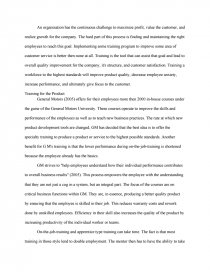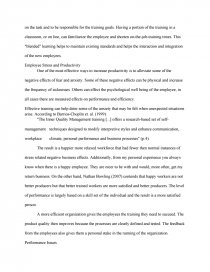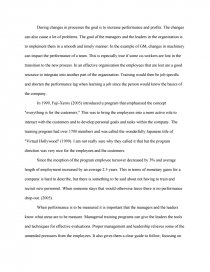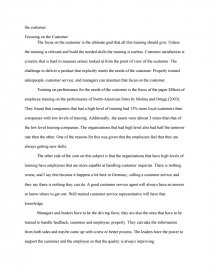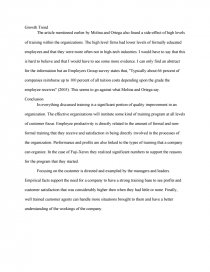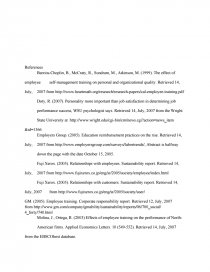The Effect Of Training On Quality Improvement
Essay by 24 • December 25, 2010 • 1,690 Words (7 Pages) • 1,735 Views
Essay Preview: The Effect Of Training On Quality Improvement
An organization has the continuous challenge to maximize profit, value the customer, and realize growth for the company. The hard part of this process is finding and maintaining the right employees to reach this goal. Implementing some training program to improve some area of customer service is better then none at all. Training is the tool that can assist that goal and lead to overall quality improvement for the company, it's structure, and customer satisfaction. Training a workforce to the highest standards will improve product quality, decrease employee anxiety, increase performance, and ultimately give focus to the customer.
Training for the Product
General Motors (2005) offers for their employees more then 2000 in-house courses under the guise of the General Motors University. These courses operate to improve the skills and performance of the employees as well as to teach new business practices. The rate at which new product development tools are changed, GM has decided that the best idea is to offer the specialty training to produce a product or service to the highest possible standards. Another benefit for G M's training is that the lower performance during on-the-job-training is shortened because the employee already has the basics.
GM strives to "help employees understand how their individual performance contributes to overall business results" (2005). This process empowers the employee with the understanding that they are not just a cog in a system, but an integral part. The focus of the courses are on critical business functions within GM. They are, in essence, producing a better quality product by ensuring that the employee is skilled in their job. This reduces warranty costs and rework done by unskilled employees. Efficiency in their skill also increases the quality of the product by increasing productivity of the individual worker or teams.
On-the-job-training and apprentice type training can take time. The fact is that most training in those style lend to double employment. The mentor then has to have the ability to take on the task and to be responsible for the training goals. Having a portion of the training in a classroom, or on line, can familiarize the employee and shorten on-the-job-training times. This "blended" learning helps to maintain existing standards and helps the interaction and integration of the new employees.
Employee Stress and Productivity
One of the most effective ways to increase productivity is to alleviate some of the negative effects of fear and anxiety. Some of these negative effects can be physical and increase the frequency of sicknesses. Others can effect the psychological well being of the employee, in all cases there are measured effects on performance and efficiency.
Effective training can help deter some of the anxiety that may be felt when unexpected situations arise. According to Barrios-Choplin et. al. (1999):
"The Inner Quality Management training [...] offers a research-based set of self-management techniques designed to modify interpretive styles and enhance communication, workplace climate, personal performance and business processes" (p.4).
The result is a happier more relaxed workforce that had fewer then normal instances of stress related negative business effects. Additionally, from my personal experience you always know when there is a happy employee. They are nicer to be with and would, more often, get my return business. On the other hand, Nathan Bowling (2007) contends that happy workers are not better producers but that better trained workers are more satisfied and better producers. The level of performance is largely based on a skill set of the individual and the result is a more satisfied person.
A more efficient organization gives the employees the training they need to succeed. The product quality then improves because the processes are clearly defined and tested. The feedback from the employees also gives them a personal stake in the running of the organization.
Performance Issues
During changes in processes the goal is to increase performance and profits. The changes can also cause a lot of problems. The goal of the managers and the leaders in the organization is to implement them in a smooth and timely manner. In the example of GM, changes in machinery can impact the performance of a team. This is especially true if some co-workers are lost in the transition to the new process. In an effective organization the employees that are lost are a good resource to integrate into another part of the organization. Training would then be job specific and shorten the performance lag when learning a job since the person would know the basics of the company.
In 1999, Fuji-Xerox (2005) introduced a program that emphasized the concept "everything is for the customers." This was to bring the employees into a more active role to interact with the customers and to develop personal goals and tasks within the company. The training program had over 1700 members and was called the wonderfully Japanese title of "Virtual Hollywood" (1999). I am not really sure why they called it that but the program direction was very nice for the employees and the customers.
Since the inception of the program employee turnover decreased by 3% and average length of employment increased by an average 2.5 years. This in terms of monetary gains for a company is hard to describe, but there is something to be said about not having to train and recruit new personnel. When someone stays that would otherwise leave there is no performance drop-out. (2005).
When performance is to be measured it is important that the managers and the leaders know what areas are to be measure. Managerial training programs can give the leaders the tools and techniques for effective evaluations. Proper management and leadership relieves some of the unneeded pressures from the employees. It also gives them a clear guide to follow; focusing on the customer.
Focusing on the Customer
The focus on the customer is the ultimate goal that all this training should give. Unless the training is relevant and build the needed skills the training is useless. Customer satisfaction is a metric that is hard to measure unless looked at from the point of view of the customer. The challenge to deliver a product that explicitly meets the needs of the customer. Properly trained salespeople, customer service, and managers can maintain that focus on the customer.
Training on performance for the needs of the customer is the focus of the paper Effects of employee training on the performance of North-American firms by Molina and Ortega (2003). They found that
...
...
